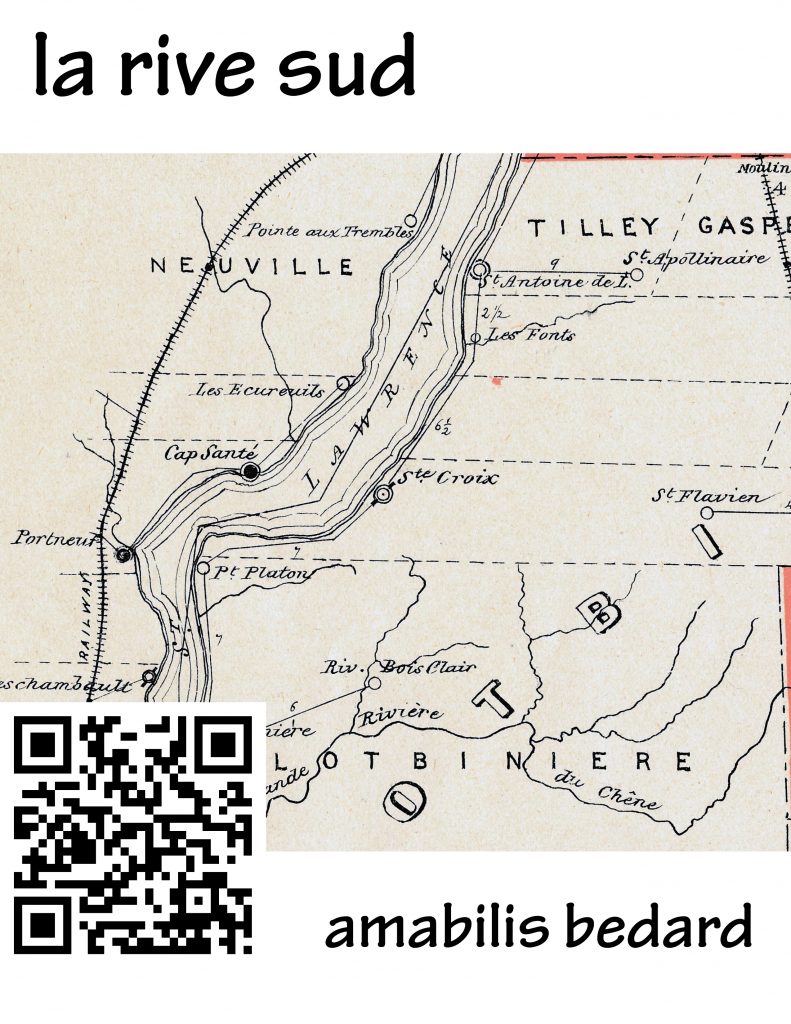There is little to no mention of the First World War in my grandmother’s memoirs. With five sisters and only one brother who was too young to fight, this was not surprising. But when she left for school, the Spanish flu gripped Québec and the rest of the world. There was no vaccine.
School
During the spring and fall, we would walk to school on roads and paths that were not always nice, especially after rainstorms.
In winter, we stayed at school with the teacher all week. Monday morning, our father would take us by sleigh to school. We had all our supplies for the week packed, and rode well bundled under the big hide blanket.
My oldest sister, Amarilda, prepared our meals. She was good to us, always keeping us occupied and helping us with our lessons. At night, we slept on a bench bed, placed up tight behind the class desks.
Amarilda Hébert, born 11 June 1899, married Arthur Hébert and had fifteen (15) children. Héberts often married Héberts in Sainte Croix. There’s only so many colonial family names to go around.
One lunch during our midday break, Joseph Demers was barefoot and began literally dancing on the desks, jumping from one to the other, much to the displeasure of Alexandra Desrochers.
She truly did not like nor appreciate this because as soon as Joseph came within striking distance, she stabbed his foot with her knife. In those days, a good knife was essential for everything. Everyone needed one and Mlle. Desrochers was handy with hers.
Seeing the blood flow, Joseph’s sisters became hysterical. He was the only boy of the family and thus coddled and spoiled by his sisters. He went home to get bandaged up that day and I don’t remember him dancing in class ever again, he lost the urge.
When I turned seven (in 1909), we had to go to a convent for a month to prepare for our First Communion. I was so happy at home and so sad to go. My sister, Anne Marie, who was six, was very lonely without me, as she was when I left home to go to boarding school.
Saint Damien
When I turned fifteen, it was time to go to boarding school at the convent at Saint Damien. I cried all the way to the train station. I was leaving all of my people for one year, but I had wanted to do it. My cousin, Marcel Laliberté, was also going to Saint Damien, so I traveled with him.

The train came to a stop at Saint Apollinaire. Curious as a weasel, Marcel stuck his head out of the window to find out why, only to get a shower of water on his head from the water tank used to replenish the steam engine. I thought this was so funny that I didn’t cry the rest of the way to Saint Damien.
I became very used and acclimated to boarding school, even though nothing there was very modern. All in all, my time at the convent left me with some unforgettable memories and learned habits. My love of reading and learning came from my time there. I can never forget Sister Sainte Victoria and Sister Sainte Beatrix.

The Spanish Flu
Spanish Flu hit North America in the winter of 1918. Over 50,000 Canadians died. Amabilis was one of 500,000 who fell sick but survived. As much of 6% of the world’s population succumbed. Rather than targeting the juvenile and the elderly, the Flu seemed to target the fit, young adults whose immunity system overresponded to the virus.
One bad memory amidst all the good ones in my youth was the Spanish Flu. Sixty of us children became sick, but not one died. At one point, after I had recovered, they told me that they wanted to give me last rites. I was so out of my head and delirious that I remember nothing.
When I was recovering, instead of asking for a glass of water while lying in bed, I decided to get up out of bed and out to the hallway where there was a sink. I became aware of a nun, all dressed in white, who was sleeping on a couch in the hallway. Seeing her, I screamed, thinking that she was the undead, resurrected version of a nun I knew who had died from the flu.
There were many nightmares, which were thought caused by the high fevers which accompanied the Spanish Flu. A curé, who was sleeping at the convent, possibly taking a break from his parish, began to cry out in the night like an owl.
“Oooh! Oooh! Oooh!” He went on and on and woke everyone up. Many of the girls were terrified, thinking that yet another nun had come back from the dead.
Someone had to break into his locked room through the small window over the door to wake him up and out of his nightmare, all the while reassuring him that it was all right.
The flu killed fourteen nuns who were in mission and another few who expired at the motherhouse. When a nun died, they brought her into the main foyer, next to the stairs, where she passed the night. The next day, the retired folks who lived at the retirement home on the premises would take the coffin out to the cemetery for internment.
When I began to recover, I would stand by the window and watch each funeral cortege head to the cemetery.
Nobody went to church, fearing the flu. The church bells didn’t ring out for any of the funerals – there were too many dead and they didn’t want to panic the populace. My classmates were getting news from their villages and it wasn’t good, letters often announced deaths in their immediate families. Sometimes an envelope carried news of as many as three or four deaths.
I was very worried for my parents. One nun forgot to give me a letter from my parents before she fell sick with the flu. Once she recovered, she remembered the letter and quickly brought it to me. Everyone at home was thankfully all right, but it was a frightening time waiting for the mail.





